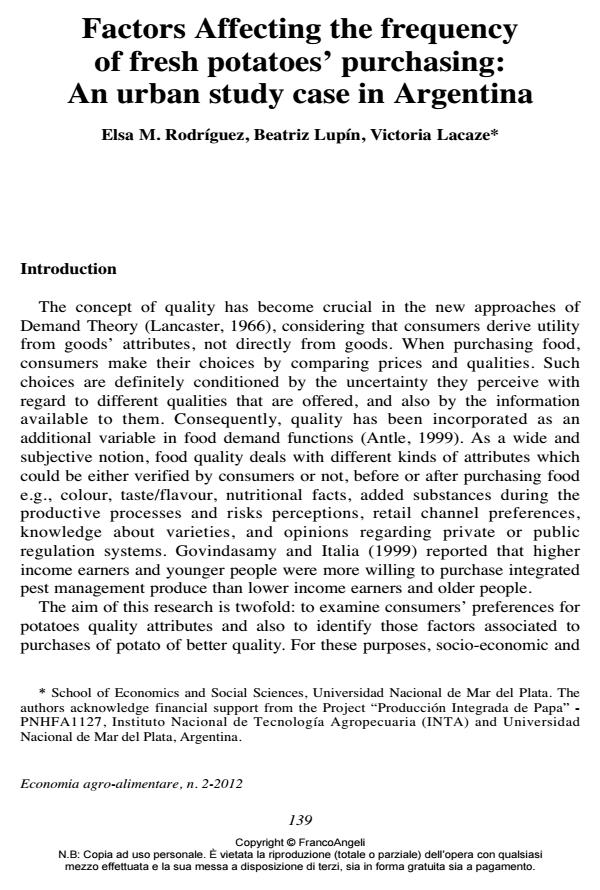Factors Affecting the frequency of fresh potatoes’ purchasing: An urban study case in Argentina
Journal title ECONOMIA AGRO-ALIMENTARE
Author/s Elsa M. Rodrìguez, Beatriz Lupìn, Victoria Lacaze
Publishing Year 2012 Issue 2012/2
Language Italian Pages 14 P. 139-152 File size 147 KB
DOI 10.3280/ECAG2012-002007
DOI is like a bar code for intellectual property: to have more infomation
click here
Below, you can see the article first page
If you want to buy this article in PDF format, you can do it, following the instructions to buy download credits

FrancoAngeli is member of Publishers International Linking Association, Inc (PILA), a not-for-profit association which run the CrossRef service enabling links to and from online scholarly content.
When purchasing food, consumers make their choices by comparing prices and qualities. As a wide and subjective notion, food quality deals with different kinds of attributes. They could be either verified by consumers or not before or after purchasing food e.g., colour, taste/flavor, nutritional facts, added substances during the productive processes, risks perceptions, and retail channel preferences. The aim of this research is to examine consumers’ preferences for fresh potatoes quality attributes and also to identify those factors associated to purchases of potato of better quality. Data come from a household survey conducted in Mar del Plata city, Argentina, in June 2009. A representative sample of the population included 500 randomly selected households. Related to potato nutrients, 50% of the sample mentioned at least one nutrient (carbohydrates 83%, vitamins 24%, potassium 16%, and fibre 12%). Households with many members have a higher probability to consume fresh potato more frequently than smaller households, and older respondents consume fresh potato more frequently than younger individuals. Households considering potato as a relevant component of a balanced diet are likely to consume fresh potatoes more frequently than households that did not emphasized the role of this product in their meals. Consumer perception about the relationship between price and quality showed that the higher educational level, the lower the number of respondents who declared that the price is a trustful sign of quality. Finally, when asked about willingness-to-pay for fresh potatoes of better quality, 34% of households were willing to pay a premium of 0.13 US$/kg and 19% were willing to pay a price premium of 0.26 US$/kg.
Keywords: Fresh potatoes, quality attributes, perceptions, willingness-to-buy
Jel codes: D1, D12, Q13
- Tüketicilerin Patates Tüketim Tercih ve Davranışlarını Etkileyen Faktörlerin Analitik Hiyerarşi Süreci İle Tespiti: Erzurum İli Örneği Adem Aksoy, Emine İKİKAT TÜMER, in Atatürk Üniversitesi Ziraat Fakültesi Dergisi /2019 pp.122
DOI: 10.17097/ataunizfd.466262
Elsa M. Rodrìguez, Beatriz Lupìn, Victoria Lacaze, Factors Affecting the frequency of fresh potatoes’ purchasing: An urban study case in Argentina in "ECONOMIA AGRO-ALIMENTARE" 2/2012, pp 139-152, DOI: 10.3280/ECAG2012-002007